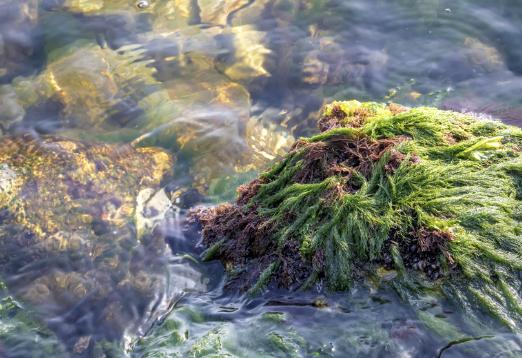Like trees on land, marine plants play an important role in the health of the planet. Underwater forests absorb carbon from the air (carbon sinks), and store it long-term. They provide homes and food for wildlife, create economic opportunities, and keep nature balanced.
And much like those on land, underwater forests face threats from humans, like climate change and physical damage. The destruction of this plant life harms the planet, us included.
Today, we’ll learn about seaforestation, what it is, why it’s important, and how to help.
What is seaforestation?
Seaforestation is a combination of the words sea and reforestation. It refers to efforts to conserve and restore marine plants, both in and around the water.
While there are lots of important marine plants, the below are some of the most well-researched and important.
Salt marshes
Salt marshes are wetlands near the coast that flood and drain with the tides. They protect the coastline from erosion by acting like natural barriers against waves and storms. Salt marshes also clean and filter water by trapping dirt and pollutants. They provide homes for many different animals, like fish and birds, and support a variety of plants. Salt marshes can absorb 10 times more carbon than mature tropical forests.
Kelp and Seagrass Meadows
Kelp is a large seaweed species that forms dense underwater forests. It can grow up to two feet per day. Quick growth requires frequent photosynthesis. During this process, plants absorb carbon dioxide and turn it into energy. This makes kelp an excellent carbon sink, storing up to 20 times more than land forests.
Kelp provides habitat and food for marine animals, including commercially important ones (like red abalone and herring). Also, kelp that grows near the shore protects it from storms, flooding, and erosion.
Seagrass meadows are underwater, flowering plants. They provide similar benefits to kelp. Additionally, their roots help hold sediment, creating clearer, cleaner water. Near the shore, seagrass meadows absorb nutrients from the land, making the water healthier.
Mangroves
Mangroves are trees that grow where water meets land. They provide similar benefits to the above plants. They’re particularly good at filtering pollutants from the water, and preventing erosion.
In addition to the above benefits, these plants:
1. Produce oxygen. The process of photosynthesis creates oxygen. Like us, underwater organisms need oxygen to live and breathe.
2. Boosts the economy. Healthy underwater forests support industries like fishing, aquatic farming, and tourism, like diving and snorkeling.
3. Provide learning and research opportunities. Underwater forests are great places for scientists to study and learn about marine life and the environment. Their research helps us understand our world and how to protect it.
Threats to Underwater Forests
Human activity poses a significant threat to underwater forests in many ways.
1. Climate change. Rising sea temperatures, ocean acidification, and extreme weather events threaten underwater forests, affecting their growth, reproduction, and overall health.
2. Pollution. Pollution, including chemical runoff from agriculture, sewage, pesticides, and plastic debris, negatively impacts underwater forests. It can harm plants and marine life, throwing off the ecosystem balance.
3. Overfishing. Unregulated and unsustainable fishing practices can drastically reduce fish populations. This leads to imbalances in the ecosystem. Similarly, destructive fishing methods like bottom trawling can damage underwater forests and the organisms that live there.
4. Coastal development. Developing coastal areas, e.g., construction of ports, resorts, and infrastructure, can destroy marine plants. This can cause increased erosion and water pollution.
5. Invasive species. The introduction of non-native species, intentionally or not, can damage native species.
6. Unsustainable tourism. Irresponsible tourism, like physically damaging marine plants, littering plastics, and using environmentally harmful products (like toxic sunscreen) threatens underwater forests.
Seaforestation suggestions:
For governments
1. Protect marine areas. Set up and manage protected areas for underwater forests. Enforce rules to stop harmful activities and encourage sustainable practices in these zones.
2. Enforce responsible fishing. Create rules that prevent overfishing and harmful fishing methods. Promote responsible fishing practices to maintain healthy underwater forests.
3. Involve the community. Educate and train local communities about seaforestation. Encourage participation in projects to ensure long-term success.
4. Fight climate change. Support global efforts to reduce greenhouse gas emissions and limit global warming. Addressing the causes of climate change is necessary for the health of underwater forests.
For conservationists/scientists
1. Do more research. Gather more information about effective seaforestation methods, sites, and cost-effectiveness.
2. Grow and restore kelp forests.
3. Protect seagrass meadows.
4. Plant mangrove trees. Work with local communities to plant young mangrove trees in suitable coastal areas.
5. Make floating wetlands. Get communities involved in building platforms with native plants that float on water. These wetlands clean the water, increase biodiversity, and provide shelter for fish and birds.
For individuals
1. Support local and global seaforestation organizations. Donate, volunteer, or both.
2. Boat and fish responsibly. Follow fishing regulations, avoid harmful fishing practices.
3. Be environmentally conscious. Make eco-friendly choices every day, like conserving energy, using public transportation, and reducing waste.
Key takeaways
1. Marine plants are necessary for a healthy planet. They absorb carbon, provide habitat, and support the economy.
2. Human factors, like climate change, pollution, and overfishing, threaten these ecosystems.
3. An on-going, collective effort is needed for seaforestation efforts to succeed.
Sources
https://ocean.si.edu/ocean-life/plants-algae/seagrass-and-seagrass-beds

